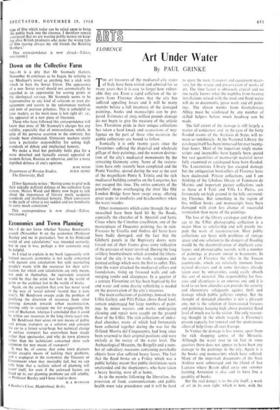Lam
By PAUL GRINKE
HE art treasures of the mediaeval city states I of Italy have been visited and admired for so many years that it is easy to forget how vulner- able they are. Even a rapid collation of the re- ports from Florence shows that the city has suffered appalling losses and it will be many months before a full inventory of the damaged paintings, books and manuscripts can be pre- pared. Estimates of sixty million pounds damage do not begin to give the measure of the artistic loss. Florentine pride in their unique collections has taken a hard knock and accusations of neg- ligence on the part of those who maintain the public collections are bound to follow.
Ironically it is only twenty years since the Florentines suffered the dispersal and wholesale pillage of their paintings, and the wanton destruc- tion of the city's mediaeval monuments by the retreating Germany army. Some of the restora- tions have only recently been completed and the Ponte Vecchio, spared during the war at the cost of the magnificent Ponte S. Trinita and the rich mediaeval building complex on the Lungarno, has not escaped this time. The entire contents of the jewellers' shops overhanging the river like Old London Bridge have been swept away, offering great scope to mudlarks and beachcombers when the water recedes. to spare the men, transport and equipment neces- sary for the rescue and preservation of works of art. The time factor is obviously crucial and no one really knows what the naphtha from heating installations mixed with the mud and flood water will do to documents, gesso work and oil paint- ings. The eleven monks from Grottaferrata Abbey must be reinforced by any number of skilled helpers before much headway can be made.
The full extent of the damage is still largely a matter of conjecture and. in the case of the forty flooded rooms of the Archivio di Stato, will re- main so indefinitely. At the National Library the catalogue itself has been immersed for over twenty- four hours. Most of the important single manu- scripts and incunables have happily been spared but vast quantities of manuscript material never fully examined or catalogued have been flooded.
The Laurenziana Library has escaped damage but the antiquarian booksellers of Florence have been decimated. Private collections, and I am thinking of the fabulous library of Tammaro de Marinis and important picture collections such as those at I Tatti and Villa La Pietra, are fortunately on high ground in the hills surround- ing Florence. But something in the region of five million books and manuscripts have been damaged with even less chance of successful restoration than many of the paintings.
The loss of the library catalogue and the dam- age to the Uffizi photographic collection is a major blow to scholarship and will greatly im- pede the work of reconstruction. Most public collections are beset with problems of storage space and one solution to the dangers of flooding would be the decentralisation of duplicate cata- logues and photographic records, with a number of paintings at present stored in basements. In the case of Florence the villas in the Tuscan countryside, which are relatively immune from






























 Previous page
Previous page